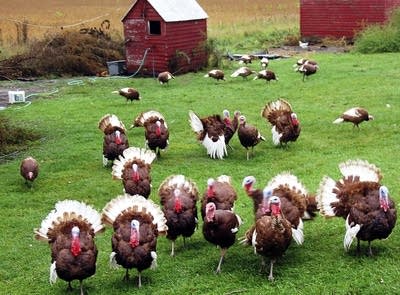Corn prices hit livestock farmers' bottom line
Go Deeper.
Create an account or log in to save stories.
Like this?
Thanks for liking this story! We have added it to a list of your favorite stories.

The price for your holiday turkey is a few cents a pound more this year than it was last year.
But livestock producers say the modest increases at the grocery store don't reflect the rapidly rising cost of raising that turkey.
Minnesota grows more turkeys than any other state. But with corn making up more than half of a turkey's diet, high corn prices are squeezing profits and in some cases forcing farmers out of the turkey business, said John Burkel, who raises turkeys near the small town of Badger in northwest Minnesota.
The market price for corn is about a dollar per bushel higher than one year ago. Even an increase of a dime in the price per bushel of corn costs Burkel about $12,000 a year.
Turn Up Your Support
MPR News helps you turn down the noise and build shared understanding. Turn up your support for this public resource and keep trusted journalism accessible to all.
"I was just looking the other day and I had a flock of turkeys go in 2006 that fed for 19 cents a pound," he said. "I was just working out my feed costs this year and I'm looking at [a] 46-cent-a-pound average."
It costs farmers about $1.10 per pound to raise and process a turkey this year, said Burkel, vice chairman of the National Turkey Federation. But many grocers sell turkeys below cost as a way to lure customers to their stores.
As a result, turkey sales are strong at Thanksgiving. But overall turkey sales are down, as per-capital turkey consumption has dropped from 17.5 pounds in 2007 to 16.1 pounds in 2011, according to the National Turkey Federation.

Burkel thinks consumers are buying less because of higher prices.
Drought across the United States this summer reduced the corn harvest and pushed prices higher. But Burkel said a big reason corn prices are so high is because a lot of corn is used to make ethanol.
Turkey, hog and beef farmers asked the Environmental Protection Agency to waive the renewable fuels mandate passed by Congress in 2005 that requires gasoline companies to meet escalating goals to blend most of the nation's ethanol output into their fuel.
But the EPA denied that request last week, saying ethanol production adds only a few cents to the price of corn.
Agricultural Economist Doug Tiffany said ethanol is only part of the grain market with only 40 percent of the corn crop going to ethanol production. After processing, about a third of the corn used to make ethanol* remains as a byproduct and is reused as animal feed.
Bigger factors in rising corn prices are drought and growing international food demand, said Tiffany, an assistant extension professor at the University of Minnesota.
"More than ever before, international demand for our grains has become important," he said. "We have strong demand from China, and as people become more prosperous they have definitely increased their consumption of meat."
But Burkel isn't buying that argument.
"I don't believe that, myself, because I've seen what's happened since ethanol came on the scene in 2007 full force," Burkel said. "And it's practically an insult to my intelligence to say it wouldn't have any impact."
There may be strong differences of opinion on what's causing higher corn prices. But the effect is clear: livestock farmers are being pinched.
Minnesota Turkey Growers Association Executive Director Steve Olson said some farmers are struggling to find feed.
"[I] talked to one guy and he's got a list of 25 farmers he buys grain from on a daily or weekly basis," Olson said. "And he went through that list and they said, 'we don't have any; we wish we had some grain available to sell to you.' "
Olson said there are no hard numbers on how many turkey farmers have given up because of high corn prices, but he has heard that some have. He said one farmer recently told him he is going out of business because the bank won't give him an operating loan.
Tiffany, the U of M agricultural economist, said conditions likely won't improve next year. He said drought is also affecting crops in South America.
"Again we'll be approaching the 2013 growing season with small reserves in the cupboard, so there will be a small carry over," he said. "So that can make things exciting."
Tiffany said the increased cost of growing turkeys and other livestock will likely be noticed by consumers as food prices continue to rise in the new year.



